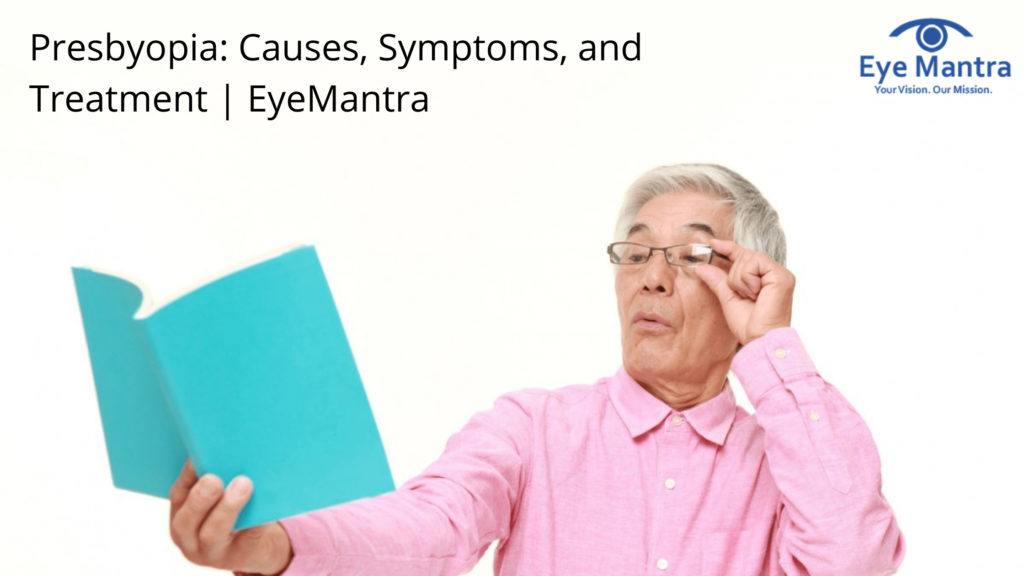It is the condition where the eyes, lose the ability to focus on nearby objects. It is a gradual process and is a natural part of aging.
It usually starts during the late 40s and may worsen by the age of 65.
A basic eye exam is used to diagnose presbyopia and can be corrected using contact lenses, eyeglasses or surgery.
Contents
SYMPTOMS OF PRESBYOPIA
The symptoms of Presbyopia are :
- A habit of holding the newspaper or other reading material farther away to make letters clear.
- Experiencing blurred vision at normal reading distance.
- Eyestrain and headaches after doing close-up work.
CAUSES OF PRESBYOPIA
When the eye forms an image it relies on the cornea and the lens to focus the light reflected from the object. The closer the object the more the lens is flexed.
The eye has three parts which helps in the reflection of the image.
- Cornea: the cornea is a clear and dome-shaped structure in front of the eye.
- Lens: The lens is a small oval-shaped clear structure.
Both of these structures bend light and refract thus entering the eye to focus the image on the retina located on the inside back wall of the eye.
The lens is flexible and often changes it’s shape with the help of the circular muscle which surrounds it. When the eye looks at something at a distance, the circular muscle relaxes while when the eye looks at something nearby the circular muscle constricts.
Presbyopia is caused by hardening of the lens of the eye which happens while ageing. As the lens becomes hard it becomes less flexible thus it cannot focus on close up images causing the images to appear out of focus.
WHO ARE AT RISK FOR PRESBYOPIA?
- AGE: age plays a great risk factor in getting presbyopia. As people age they have higher chances of getting presbyopia because the lens hardens reducing it’s felxibility with age.
- MEDICAL CONDITIONS: medical conditions such as farsightedness, diabetes, cardiovascular disease can increase your risk of getting presbyopia.
- DRUGS: intake of certain drugs can lead to premature presbyopia. These drugs include antidepressants, antihistamines.
DIAGNOSIS FOR PRESBYOPIA
Presbyopia is diagnosed by a comprehensive eye exam by your eye doctor. The ophthalmologist performs a complete eye exam and a refractive assessment to determine which eye problem the patient is suffereing from.
Your doctor might also use some eye drops in your eye so that your pupil dilates and the doctor can easily view the interior portion of the eye for a complete and exact diagnosis.
TREATMENT FOR PRESBYOPIA
Treatment for presbyopia includes the following:
- Eyeglasses: eyeglasses which have progressive lenses are the most used for people with presbyopia after the age of 40. These glasses have line free multifocal lenses which restore the clear near vision and provides excellent vision at all distance.
Another type of eyeglass that can be used to treat presbyopia is using bifocal lenses but they provide a limited range of vision for people with presbyopia.
People with presbyopia also become sensitive to light and often have glares thus using photochromic lenses is also an option which will darken the sunlight.
Another type of glasses which can be used are reading glasses. These glasses are not supposed to be worn all day. Reading glasses as the name suggests are only supposed to be worn when you are reading something like a book or a newspaper. Regardless of any glasses, you choose to correct presbyopia you should always get an anti-reflective coating on the lens. This layer elimites reflections that can be distracting and cause eye strain and also helps in reducing glare and increase clarity in vision, even at night.
- Contact lenses: To treat presbyopia patients can opt for multifocal contact lenses too. They are available in gas permeable and soft lens material too.
Another choice of contact lenses for presbyopia can be monovision where one eye has a distance prescription lens while the other has a near vision one. The brain favours the eye for the different tasks.
- Presbyopia surgery: some people do not like to wear eyeglasses or contact lenses. They prefer surgical options to treat presbyopia. There are several surgical options to treat presbyopia.
Presbyopia correction procedure is gaining popularity nowdays which is corneal inlay.
In this procedure a cornea is implanted in the dominant eye. It increases the depth of the focus of the treated eye and reduces the need for reading glasses without affecting the quality of the vision.
PREVENTION FROM PRESBYOPIA
You can’t prevent Presbyopia, but you can help protect your eyes and your vision by following these tips:
- Have your eyes checked? You should get regular eye exams. If you have any vision problems, they will get treated on time.
- Control chronic health conditions. Certain diseases, such as diabetes and high blood pressure, can affect your vision if not treated.
- Protect your eyes from the sun. Wear sunglasses that block ultraviolet (UV) radiation from the sun
- Prevent eye injuries. You should try to wear protective eyewear when using products with toxic fumes for examples of spray paints.
- Eat healthy foods. You should try to eat leafy greens, other vegetables and fruits. According to some studies eating diet fish like tuna and salmon benefits your eyes too.
- Don’t smoke. Smoking has a bad effect on your eyes as well.
- Use the right corrective lenses. The right lenses optimize your vision. You should take regular exams to ensure that your prescription glasses are correct.
- Use good lighting. Use good lighting for the place you work to reduce eyestrain.
To diagnose or treat your presbyopia contact our eye care centre ”Eyemantra Care” for a comprehensive eye exam by our team of experienced and well-trained ophthalmologists. Book an appointment on: Ph:+91-9711115191

